植物生理学
2010-1
科学
诺贝尔
581
我们先从这本书的书名说起。“Physiology”(生理学)是研究细胞、器官和生物的功能的科学,来源于拉丁文Physiologia,后者来自希腊语的前缀“physi”或“physio”(自然)和“logos”(道理思想)。因此,生理学这个名字,从开始便意味着隶属于自然科学,现在则是专指生物学中研究生物特征——生命过程和活动的一个分支。“Physicochemical”(物理化学)是有关物理和化学性质;“Environmental”(环境)是指日照和风等。尽管本书的主要内容集中在“植物”,但是所用方法、推导的公式和附录也同样适用于动物和其他生物。本书重点讨论了植物的水分关系、溶质运输、光合作用、蒸腾作用、呼吸作用,以及与环境的相互作用。生理学者的研究任务旨在理解物理和化学方面的相关内容,从而构建出精确的模型、预测生物对内部和外部环境的反应。因此,应用基础化学、物理和数学可以发展一些概念,这些概念对我们研究生物学非常重要,其目的是提供一个严谨的发展过程而非简单的事实概要。虽然一些章节中阐述的原理已向读者呈现了植物生理学领域研究的前沿,但每章仍提供了扩展阅读的参考文献。书中使用各种计算用以表明各种方程的生理意义,并在每章后面提供了更进一步练习的题目。附录中有问题的答案,还包括各种温度下常数和转化因子数值的列表。第1~3章讲述植物细胞水分关系和离子运输。第1章在讨论扩散的概念之后,我们分析了细胞膜和细胞器膜对扩散的物理屏障。另外一个物理屏障是限制植物细胞大小的细胞壁。第2章,在讨论水在特定力作用下进入细胞这一运动时,我们引入了热力学理论——化学势梯度。第3章描述溶质进出植物细胞的运动,引出跨膜电势梯度的概念以及区分扩散和主动运输的标准。基于不可逆热力学概念,我们导出了一个重要的参数——反射系数,可以精确评估渗透压对流动的影响。
《植物生理学:物理化学与环境》(原著第四版)利用化学、物理和数学的基本原理来解释和发展植物生理的重要概念——展示所有发生在细胞、组织、器官、生物体甚至生态系统中的生理过程:是如何以最基本的方式来遵循这些原理的。讨论的主题包括叶片及整个植物体内的扩散、膜、水分关系、离子运输、光化学、能量转换的生物能学、光合作用、环境对植物温度的影响以及气体交换。第四版仍然保持了Nboel一贯的清晰表达,并在前几版的基础上加以完善,更方便读者使用。 这不仅是一本优秀的教科书,也是一部愈显珍贵的参考著作。本书第四版在保留系列著作(1970年以来7本)中广获好评的清晰敏锐风格的同时,使涵盖内容更广泛、阐述方式更精悍、图释注解更丰富。
作者:(美国)诺贝尔(Park S.Nobel)
前言 符号与缩略词 1.细胞与扩散 1.1.细胞结构 1.2.扩散 1.3.膜结构 1.4.膜渗透 1.5.细胞壁 1.6.问题 1.7.参考文献和扩展阅读 2.水 2.1.物理特性 2.2.化学势 2.3.中央液泡与叶绿体 2.4.水势和植物细胞 2.5.问题 2.6.参考文献和扩展阅读 3.溶质 3.1.离子化学势 3.2.流动与扩散电位 3.3.跨膜运输特性 3.4.跨膜运输机理 3.5.不可逆过程的热力学原理 3.6.溶质跨膜运动 3.7.问题 3.8.参考文献和扩展阅读 4.光 4.1.波长与能 4.2.分子的光吸收 4.3.去激发 4.4.吸收光谱和作用光谱 4.5.问题 4.6.参考文献和扩展阅读 5.光合作用的光化学 5.1.叶绿素-化学与光谱 5.2.其他光合色素 5.3.光合色素间的激发传递 5.4.光合色素的群体作用 5.5.电子流 5.6.问题 5.7.参考文献和扩展阅读 6.生物能 6.1.Gibbs自由能 6.2.生物能的贮存形式 6.3.叶绿体的生物能学 6.4.线粒体的生物能学 6.5.生物圈的能量流动 6.6.问题 6.7.参考文献和扩展阅读 7.温度和能量收支 7.1.能量收支-辐射 7.2.热传导和对流 7.3.潜热-蒸腾作用 7.4.能量收支的进一步举例 7.5.土壤 7.6.问题 7.7.参考文献和扩展阅读 8.叶片与水、气流动 8.1.阻力与导度-蒸腾作用 8.2.蒸腾过程中的水蒸气流动 8.3.CO2的传导和阻力 8.4.光合作用过程中的CO2流动 8.5.水分利川效率 8.6.问题 8.7.参考文献和扩展阅读 9.植物与水、气流动 9.1.植物冠层上的气体流动 9.2.植物群落内的气体流动 9.3.土壤中的水分移动 9.4.木质部和韧皮部中的水分移动 9.5.土壤-植物-水连续体 9.6.问题 9.7.参考文献和扩展阅读 问题答案 附录Ⅰ.常数和系数值 附录Ⅱ.换算系数和定义 附录Ⅲ.数学关系 Ⅲ.A.前缀(度量单位) Ⅲ.B.面积和体积 Ⅲ.C.对数 Ⅲ.D.二次方程 Ⅲ.E.三次方程 Ⅲ.F.微分方程 附录Ⅳ.Gibbs自由能和化学势 Ⅳ.A.熵和平衡 Ⅳ.B.Gubbs自由能 Ⅳ.C.化学势 Ⅳ.D.μj的压力依存 Ⅳ.E.μj的浓度依存 索引
插图:One immediate impression of plant cells is the great prevalence of membranes. In addition to surrounding the cytoplasm, membranes also separate various compartments in the cytoplasm. Diffusion of substances across these membranes is much more difficult than is diffusion within the compartments. Thus, organelle and vacuolar membranes can control the contents and consequently the reactions occurring in the particular compartments that they surround. Diffusion can also impose limitations on the overall size of a cell because the time for diffusion can increase with the square of the distance, as we will quantitatively consider in the next section. Although many plant and algal cells share most of the features indicated in Figure 1-1, they are remarkably diverse in size. The cells of the green alga Chlorella are approximately 4 x 10-6m (4 ~tm) in diameter. In contrast, some species of the intertidal green alga Valonia have multinucleated cells as large as 20 mm in diameter. The genera Chara and NiteUa include freshand brackish-water green algae having large internodal cells (Fig. 3-13) that may be 100 mm long and 1 mm in diameter. Such large algal cells have proved extremely useful for studying ion fluxes, as we consider in Chapter 3 (e.g., Sections 3.2E; 3.3E,F).1.1 B. Leaf Anatomy A cross section of a typical angiosperm (seed plant) leaf can illustrate various cell types and anatomical features that are important for photosynthesis and transpiration. Leaves are generally 4 to 10 cells thick, which corresponds to a few hundred micrometers (Fig. 1-2). An epidermis occurs on both the upper and the lower sides of a leaf and is usually one cell layer thick. Except for the guard cells, epidermal cells usually are colorless because their cytoplasm contains few, if any, chloroplasts (depending on the species). Epidermal cells have a relatively thick waterproof cuticle on the atmospheric side (Fig. 1-2). The cuticle contains cutin, which consists of a diverse group of complex polymers composed principally of esters of 16- and 18-carbon monocarboxylic acids that have two or three hydroxyl groups (esterification refers to the chemical joining of an acid and an alcohol resulting in the removal of a water molecule). Cutin is relatively inert and also resists enzymatic degradation by microorganisms, so it is often well preserved in fossil material. We will consider its role in minimizing water loss from a leaf. Between the two epidermal layers is the mesophyll (literally, middle of the leaf) tissue, which is usually differentiated into chloroplast-containing "palisade" and "spongy" cells. The palisade cells are often elongated perpendicular to the upper epidermis and are found immediately beneath it (Fig. 1-2). The spongy mesophyll cells, located between the palisade mesophyll cells and the lower epidermis, are loosely packed, and intercellular air spaces are conspicuous. In fact, most of the surface area of both spongy and palisade mesophyll cells is exposed to air in the intercellular spaces, facilitating diffusion of gases into or out of the cells.
《植物生理学:物理化学与环境(原著第4版)(导读版)》的前言和目录均已译成中文,正文部分保留英文原版。另附南京农业大学生命科学学院沈振国教授所作的中文导读一篇。第一章 细胞与扩散第二章 水第三章 溶质第四章 光第五章 光合作用的光化学第六章 生物能第七章 温度和能量收支第八章 叶片与水、气流动第九章 植物与水、气流动

国内这样的书不多,而且往往跟不上最新的信息。那些有能力更新知识的教授们都忙着赚钱,没空搞这些翻译。那只好看原版了。准博士了,必须看看这方面的书。
商品来很快,东西也不错
商品来很快,东西也不错
商品来很快,东西也不错
可以算是提高英语阅读能力吧
英文原版,需要较强的英文阅读能力
若果是彩色的就实在完美了,讲的很详细,很有助于提高译文水平,考研、专业英语好帮手啊